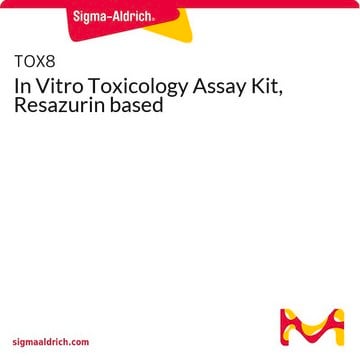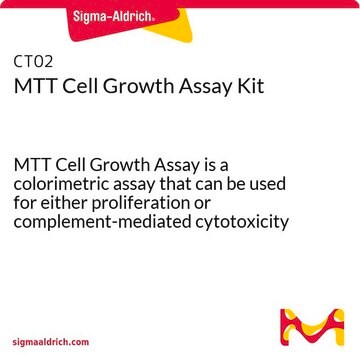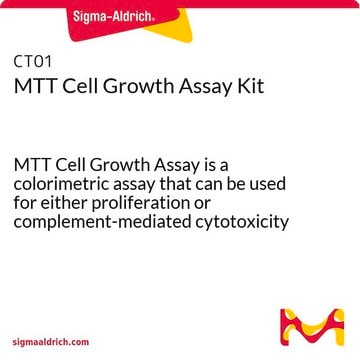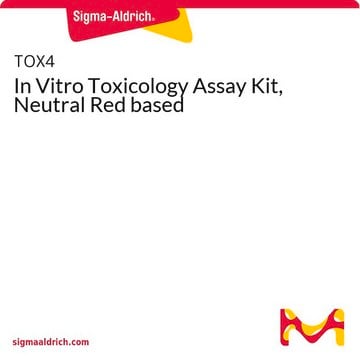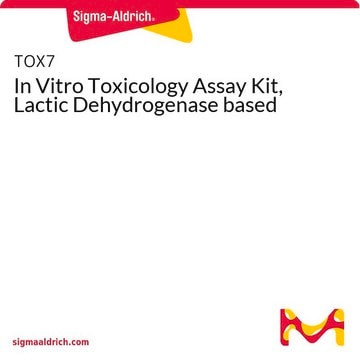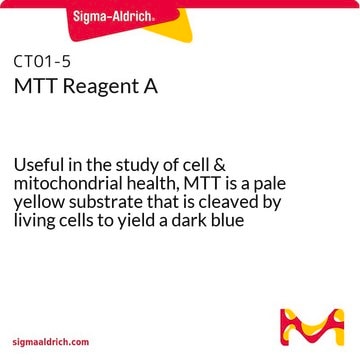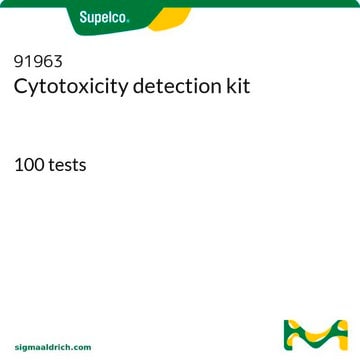The MTT asay is a method to assess cell viability. This assay is a semiquantitative assay. The assay is used to compare the viability changes in treated cells to untreated cells. The absorbance is indicative of the cell number. The higher the absorbance, the greater the number of viable cells present. Most researchers compare the absorbance of the two samples as a ratio (ABS treated cells/ABS untreated cells) to get a fold increase/decrease in cell number.
Wichtige Dokumente
TOX1
In-vitro-Toxikologieassay-Kit, MTT-basiert
Synonym(e):
mitochondrial activity assay
About This Item
Empfohlene Produkte
Verwendung
1 kit sufficient for 1,000 tests
Verpackung
pkg of 1 kit
Lagerbedingungen
dry at room temperature
λmax
570 nm
Anwendung(en)
cell analysis
detection
Nachweisverfahren
colorimetric
Lagertemp.
2-8°C
Allgemeine Beschreibung
Anwendung
Biochem./physiol. Wirkung
Ähnliches Produkt
Signalwort
Danger
Gefahreneinstufungen
Aquatic Acute 1 - Aquatic Chronic 2 - Eye Dam. 1 - Flam. Liq. 2 - Muta. 2 - Skin Corr. 1 - STOT SE 3
Zielorgane
Central nervous system, Respiratory system
Lagerklassenschlüssel
3 - Flammable liquids
Flammpunkt (°F)
53.6 °F
Flammpunkt (°C)
12 °C
Hier finden Sie alle aktuellen Versionen:
Besitzen Sie dieses Produkt bereits?
In der Dokumentenbibliothek finden Sie die Dokumentation zu den Produkten, die Sie kürzlich erworben haben.
Kunden haben sich ebenfalls angesehen
Artikel
Quality control guidelines to maintain high quality authenticated and contamination-free cell cultures. Free ECACC handbook download.
Zellbasierte Assays für Zellproliferation (BrdU, MTT, WST1), Zellviabilität und Zytotoxizitätsversuche für Anwendungen in der Krebs- und Stammzellforschung und in den Neurowissenschaften.
Cell based assays for cell proliferation (BrdU, MTT, WST1), cell viability and cytotoxicity experiments for applications in cancer, neuroscience and stem cell research.
-
Is the MTT assay quantitative?
1 Antwort-
Hilfreich?
-
-
What is the Department of Transportation shipping information for this product?
1 Antwort-
Transportation information can be found in Section 14 of the product's (M)SDS.To access the shipping information for this material, use the link on the product detail page for the product.
Hilfreich?
-
-
What is the difference between product CGD1, Cell Growth Determination Kit and product TOX1, In Vitro Toxicology Assay Kit?
1 Antwort-
Product CGD1 and TOX1 are both MTT based assays. The major difference between product CGD1 and TOX1 is that TOX1 contains 10 % Triton X-100 in the solubilization solution for better lysis of the cells and solubilization of the MTT. If there is complete cell lysis, the results obtained with both kits would be the same. The MTT in this kit is a solution, whereas the TOX1 assay kit contains the MTT as a powder that is solubilized before use.
Hilfreich?
-
Aktive Filter
Unser Team von Wissenschaftlern verfügt über Erfahrung in allen Forschungsbereichen einschließlich Life Science, Materialwissenschaften, chemischer Synthese, Chromatographie, Analytik und vielen mehr..
Setzen Sie sich mit dem technischen Dienst in Verbindung.


